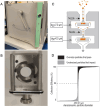Particles in Exhaled Air (PExA): Clinical Uses and Future Implications
- PMID: 38786270
- PMCID: PMC11119244
- DOI: 10.3390/diagnostics14100972
Particles in Exhaled Air (PExA): Clinical Uses and Future Implications
Abstract
Access to distal airway samples to assess respiratory diseases is not straightforward and requires invasive procedures such as bronchoscopy and bronchoalveolar lavage. The particles in exhaled air (PExA) device provides a non-invasive means of assessing small airways; it captures distal airway particles (PEx) sized around 0.5-7 μm and contains particles of respiratory tract lining fluid (RTLF) that originate during airway closure and opening. The PExA device can count particles and measure particle mass according to their size. The PEx particles can be analysed for metabolites on various analytical platforms to quantitatively measure targeted and untargeted lung specific markers of inflammation. As such, the measurement of distal airway components may help to evaluate acute and chronic inflammatory conditions such as asthma, chronic obstructive pulmonary disease, acute respiratory distress syndrome, and more recently, acute viral infections such as COVID-19. PExA may provide an alternative to traditional methods of airway sampling, such as induced sputum, tracheal aspirate, or bronchoalveolar lavage. The measurement of specific biomarkers of airway inflammation obtained directly from the RTLF by PExA enables a more accurate and comprehensive understanding of pathophysiological changes at the molecular level in patients with acute and chronic lung diseases.
Keywords: PExA; acute respiratory distress syndrome; asthma; particles in exhaled air.
Conflict of interest statement
All authors declare no conflicts of interest.
Figures



References
-
- NHS England Respiratory Disease. [(accessed on 11 November 2023)]. Available online: https://www.england.nhs.uk/ourwork/clinical-policy/respiratory-disease/
-
- Soriano J.B., Kendrick P.J., Paulson K.R., Gupta V., Abrams E.M., Adedoyin R.A., Adhikari T.B., Advani S.M., Agrawal A., Ahmadian E., et al. Prevalence and Attributable Health Burden of Chronic Respiratory Diseases, 1990–2017: A Systematic Analysis for the Global Burden of Disease Study 2017. Lancet Respir. Med. 2020;8:585–596. doi: 10.1016/S2213-2600(20)30105-3. - DOI - PMC - PubMed
-
- Intensive Care National Audit and Research Centre INCARC Reports. [(accessed on 1 March 2024)]. Available online: https://www.icnarc.org/Our-Audit/Audits/Cmp/Reports.
-
- Campling J., Jones D., Chalmers J., Jiang Q., Vyse A., Madhava H., Ellsbury G., Rabe A., Slack M. Clinical and Financial Burden of Hospitalised Community-Acquired Pneumonia in Patients with Selected Underlying Comorbidities in England. BMJ Open Respir. Res. 2020;7:e000703. doi: 10.1136/bmjresp-2020-000703. - DOI - PMC - PubMed
Publication types
LinkOut - more resources
Full Text Sources
Research Materials

